
Chania is the second largest city of Crete and the capital of the Chania regional unit. It lies along the north coast of the island, about 70 km (43 mi) west of Rethymno and 145 km (90 mi) west of Heraklion.
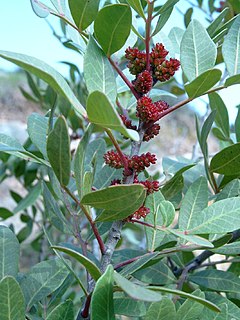
Pistacia lentiscus is a dioecious evergreen shrub or small tree of the genus Pistacia, growing up to 4 m (13 ft) tall which is cultivated for its aromatic resin, mainly on the Greek island of Chios.
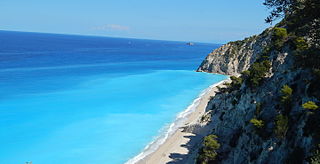
Tourism in Greece has been a key element of the economic activity in the country, and is one of the country's most important sectors. Greece has been a major tourist destination and attraction in Europe since antiquity, for its rich culture and history, which is reflected in large part by its 18 UNESCO World Heritage Sites, among the most in Europe and the world as well as for its long coastline, many islands, and beaches.
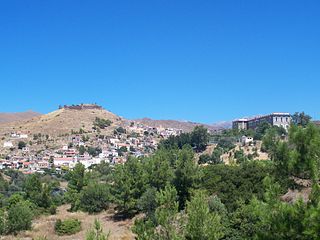
Volissos is the largest village in the northwest part of Chios, Aegean Islands, Greece. The village is situated 40 km away from the main town of Chios.

Evdilos is a village and a former municipality in the central part of the island of Ikaria, North Aegean, Greece. Since the 2011 local government reform it is part of the municipality Ikaria, of which it is a municipal unit. 40 km northwest of Agios Kirykos. Its name means visible and freely rendered open horizon.
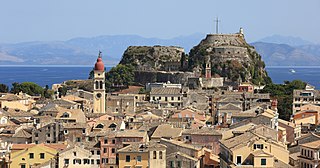
Corfu or Kerkyra is a city and a former municipality on the island of Corfu, Ionian Islands, Greece. Since the 2011 local government reform, it is part of the municipality of Corfu island. It is the capital of the island and of the Corfu regional unit. The city also serves as a capital for the region of the Ionian Islands. The city is a major tourist attraction, and has played an important role since antiquity.

Çeşme[ˈtʃeʃme] is a coastal town and the administrative centre of the district of the same name in Turkey's westernmost end, on a promontory on the tip of the peninsula that also carries the same name and that extends inland to form a whole with the wider Karaburun Peninsula. It is a popular holiday resort and the district center, where two thirds of the district population is concentrated. Çeşme is located 85 km west of İzmir, the largest metropolitan center in Turkey's Aegean Region. There is a six-lane highway connecting the two cities. Çeşme district has two neighboring districts, Karaburun to the north and Urla to the east, both of which are also part of İzmir Province. The name "Çeşme" means "fountain" and possibly draws reference from the many Ottoman fountains that are scattered across the city.
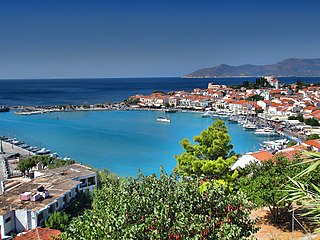
Pythagoreio is a small town and former municipality on the island of Samos, North Aegean, Greece. Since the 2011 local government reform, it is part of the municipality Samos, of which it is a municipal unit. Population 7,996 (2011). It is the largest municipal unit in land area on Samos, at 164.662 km2 (63.576 sq mi). It shares the island with the municipal units of Vathy, Karlovasi, and Marathokampos. The archaeological remains in the town, known collectively as Pythagoreion, has designated a joint UNESCO World Heritage Site with nearby Heraion.

Mastichochoria is a former municipality on the island of Chios, North Aegean, Greece. Since the 2011 local government reform it is part of the municipality Chios, of which it is a municipal unit. It is located in the southwestern and extreme southern part of the island. It is the largest municipal unit in land area on Chios at 211.687 km2. Its population was 3,672 at the 2001 census. The seat of the municipality was Pyrgi. The next largest villages are Kalamotí (569), Armólia (442), Mestá (337), and Lithío (397). The small coastal village of Emporeios (47) boasts an archaeological site.
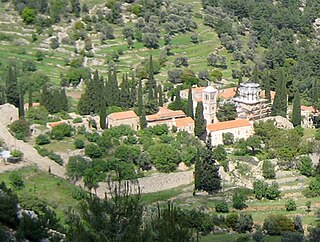
Nea Moni is an 11th-century monastery on the island of Chios that has been recognized as a UNESCO World Heritage Site. It is located on the Provateio Oros Mt. in the island's interior, about 15 km from Chios town. It is well known for its mosaics, which, together with those at Daphni and Hosios Loukas, are among the finest examples of "Macedonian Renaissance" art in Greece.
Elata is a Greek village on the island of Chios. The village is situated on hilly terrain and has a population of several hundred.

Nenita is a town in Ionia, Chios, Greece. It is located in the south-east Chios, 17 km south of Chios (town). Nenita belongs to Chios municipality and Ionia municipal unit. Its population is 903 inhabitants according to 2011 census.
The 2012 Chios Forest Fire was a wildfire that broke out in the southern half of the Greek island of Chios shortly after 2 a.m. on Saturday 18 August 2012.

Manolas is the main settlement and the capital of Therasia, the small island opposite to Santorini (Thera). It is located in the east of island, above the abrupt Santorini caldera. So it has a beautiful view for volcano and the main settlements of Santorini such as Fira, Imerovigli, Oia etc. The approach of Manolas becomes whether through the car road from the port of Riva or the uphill path from the small port of Korfos. The donkeys are the main transport mean in this path. Manolas has a population of 160 inhabitants according to 2011 census. It belongs to Thira municipality and Oia municipal unit.
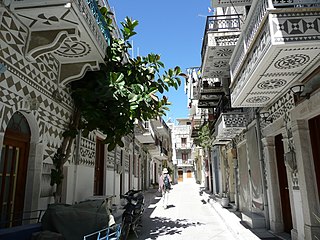
Pyrgi is a village on the Greek island of Chios, known as the "painted village" on account of the decoration of the houses. This mostly consists of black and white decorative motifs in different shapes. Pyrgi is one of the biggest villages in Chios, located in the south part of the island, 25 km south of the island's capital. It is the traditional seat of the Mastic Villages, a group of villages where the residents engage with mastic agriculture. These villages have been added in representative List of the Intangible Cultural Heritage of Humanity of UNESCO. The population of Pyrgi is 755 inhabitants according to the 2011 census.

Pasas or Panagia is a small Greek island of the Oinousses complex in the Aegean Sea, located east of Oinousses, the largest island of the complex. Administratively, Pasas and the rest of the islands form the Oinousses municipality within the Chios regional unit.

Prinos is a village on the island of Thasos in northern Greece. The village is located in the northwest of the island, 17.4 km southwest from the island's capital and main port of Limenas, and 21.8 km north of Limenaria. The village of Skala Prinou is home to the second largest ferry port on the island, with regular routes to Kavala and Nea Peramos in mainland Greece.

The Greek Orthodox Church of the Annunciation, Manchester is a Greek Orthodox Church in Salford, Greater Manchester. Completed in 1861 in a classical architectural style, it is the oldest purpose-built Greek orthodox church in England and since 1980, a grade II listed building for its “special architectural or historic interest”. As of 2017 the church provides liturgies on Sundays and acts as a hub for a community of an estimated 2,500 Greek diaspora, particularly Greek Cypriots, British Cypriots and Greek students in Manchester.
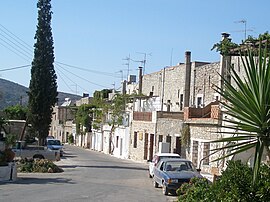

![Mastic (plant resin) A resin traditionally obtained from the mastic tree on the island of [[Chios]]](https://upload.wikimedia.org/wikipedia/commons/thumb/1/11/%D7%9E%D7%A1%D7%98%D7%99%D7%A7%D7%90_-_2.jpg/320px-%D7%9E%D7%A1%D7%98%D7%99%D7%A7%D7%90_-_2.jpg)




















